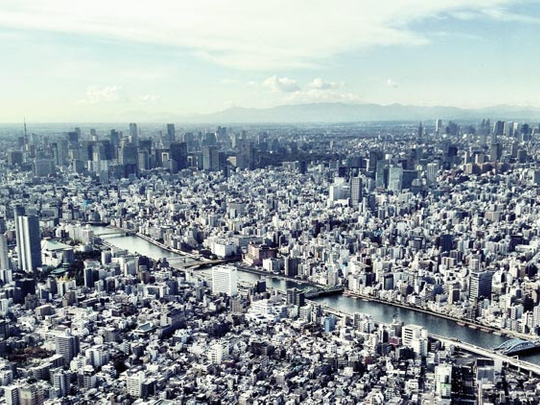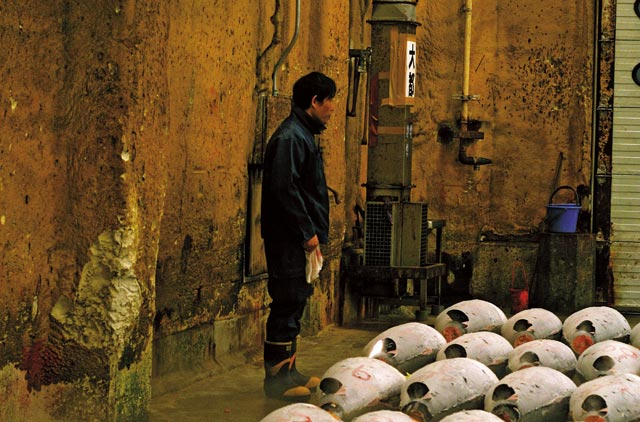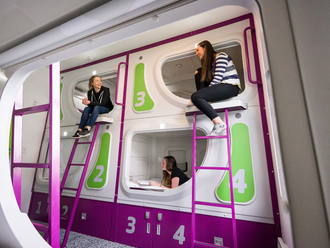
I can't sleep. It's been close to 33 hours since I've had any shut-eye and it doesn't look like I'm getting any in the hours to come. I’m not delirious yet, but bear with me if there are some chronological aberrations in my narrative. You see, the days seem to have all merged now; and for this I blame jet lag, jumping time zones and the sensory overload of Tokyo’s neon canyons. In my mind’s eye, I’m beginning to see a looping time-lapse of the past two days.
And then there’s the endless supply of sushi. It’s 6am on a bitterly cold winter morning at Iwasa Sushi, a tiny sushi restaurant the size of a small living room on the fringe of Tokyo’s famed Tsukiji Fish Market.
Misae Iwata, our genial host and landlady, is an early bird, chatting away with the patrons as the sushi chefs send plate after plate in my general direction. I’m with a bunch that’s just spent the past two hours sauntering around the world’s largest fish market. Honestly, after the first few rounds I can’t tell them apart – there are obviously recognisable sushi like the o-toro (fatty tuna) and the uni (sea urchin), but then I see something with a suspicious consistency that’s been given a miss by many before it’s passed on to me. “Shirako,” my host offers enthusiastically. The slippery, off-white fish offal (Shirako is actually milt, the sperm-filled reproductive gland of male cod fish) storms my palette before I suck it all down. All is calm. A voice inside my head coos gently, “Nitin, that’s a lifetime of bragging rights you’ve earned right now. Welcome to Tokyo.”
It’s impossible not to be overwhelmed by Tokyo. Japan’s capital is a bustling metropolis that grabs you by the collar and pulls you right in. The past and the present blend seamlessly in this city – you will confront the square and the eccentric, the modern and the orthodox, the seedy and puritanical. It is the city’s many layers that make it such a magnet for travellers.
Despite their workaholic nature, Tokyoites still believe in a good night out. The city has a throbbing nightlife, and you are never too far away from a bar. There’s a reason why Tokyo has more than 200,000 restaurants. Dinner invitations in Japan will lead you to a restaurant rather than the host’s home, the Japanese prefer entertaining out.
The city has 247 Michelin-starred restaurants; to put it in perspective, Paris has 77. But it’s not all about Michelin stars – the Yakitori grills under railway bridges in Yurakucho, the nondescript sushi restaurants in Shibuya, the speciality tempura diners in Akasaka, – Tokyo can be daunting, even for the most intrepid foodie. At Robataya, an intimate Robatayaki restaurant in Roppongi, it’s not unusual to rub shoulders with the stars. Apparently Eric Clapton and Kristen Stewart drop by when they’re in town. Food meets theatre at Robataya; the two chefs really put on a show whilst grilling meat and vegetables on an open hearth. If the food doesn’t blow you away, the atmosphere will.
Stepping out of the fabulous The Peninsula Tokyo, located on a corner facing the Imperial Palace and Hibiya Park and within walking distance from the upmarket shopping destination Ginza, I couldn’t help but notice how orderly things are here. It may have been a working day with people milling out of boutiques and offices, but they all seem to move with such purpose, it’s almost as if they are all controlled remotely.
That purpose and discipline extends to the city’s fantastic urban transport system. The Tokyo Metro is clean, efficient, quiet and easy to use. Signs ask patrons to refrain from speaking on mobile phones and Tokyoites seem disciplined enough to stick to texting and surfing the web on trains. For most tourists, mastering the JR Yamanote Line is key to conquering all of Tokyo’s hot spots. The circular Yamanote Line loops around the city’s main tourist haunts, and I jumped aboard to visit Akihabara, geek haven and possibly the biggest electronics district in the world.
Akihabara has seen its star fade away, eclipsed by the rise of Korean electronics industry, but this place was, until not so long ago, the industry’s bellwether. Akihabara is a warren of electronics shops that sell everything from components for RC cars to the latest cameras and digital watches. It’s also the home of Japan’s Otaku culture, the Tokyo’s geek elite and comic-book nerds congregate here, spending hours in the manga stores and video-game parlours, the scale of which you can’t imagine unless you actually walk through them.
All along these streets, it is not uncommon to spot girls – pretty and some possibly in their teens – dressed in French maid pinafore uniforms, distributing invitations to Maid Cafés. These are cosplay restaurants where the waiting staff are dressed like, err, French maids. If you think that is eccentric, you haven’t heard the half of it. Tokyo is home to cat cafés, where patrons pay to cuddle cats, and cuddle cafés, where you pay to snuggle up to a complete stranger. More recently, Shinjuku opened its first cuddle café that lets patrons rent butt pillows. For a fixed amount, the café will let patrons rest their tired heads on the derrières of its female staff. In my entire journalistic career, I doubt if I will ever write a stranger sentence than that last one.
I hopped on the Yamanote Line and headed to the shopping district of Shibuya. Like New York’s Time Square and Piccadilly Circus in London, Shibuya Crossing is a riot of neon lights and TV screens. The intersection, right outside the train station, is one of the busiest in the world. I stood there and soaked it all in – it only took a moment to realise that I was in one of the world’s biggest cities.
Shibuya is young, trendy, atmospheric and full of trendy bars and cafés. Just ahead from here is Omotesando Avenue, widely referred to as Tokyo’s Champs-Élysées, full of upscale boutiques and design houses. Further ahead is Harajuku, the epicentre of Japan’s edgy street fashion movement. Harajuku’s Takeshita Street has a counterculture vibe, reminiscent of London’s Camden High Street, with its token representation of punks and tattoo parlours. Fashion houses have been known to use Takeshita Street, lined with indie fashion boutiques, cafés and restaurants, to test the market for their products. If you are ever in the neighbourhood on a Sunday, be sure to catch the cosplay fashion show that takes place on the bridge.
West of this bridge stands the Meiji Shrine, an ocean of peace and quiet, unperturbed by the madness and the modernity surrounding it. A Shinto shrine dedicated to the 19th century Emperor Meiji, this place is a wonderfully serene haven of worship, devoid of tourist traps. Don’t miss the 12-metre-tall Torii gate, made of 1,500-year-old cypress, at the entrance to the 200-acre park.
I took the Yamanote Line to Yurakucho to explore Ginza. One of the first districts to modernise following the Meiji Restoration, Ginza is right there with the toniest shopping addresses in the world. With its expanse of wide avenues, dazzling neon, stylish bars and endless upscale boutiques, Ginza will top most must-visit lists in Tokyo.
It might take a week to soak in everything the city has to offer. I could easily have spent an entire day in just one of the stop-offs on the Yamanote Line, I could have done two at just Akihabara. Easy. I’ll tell you what’s difficult: getting Tokyo out of your system – and I mean this in the nicest possible way.














